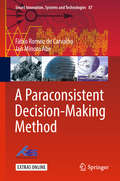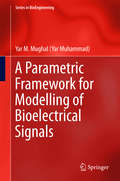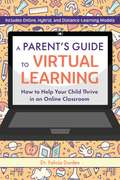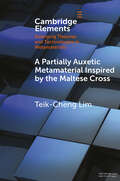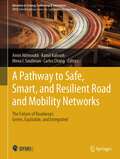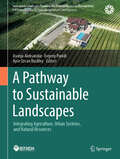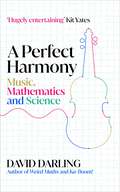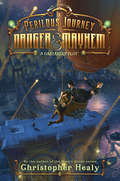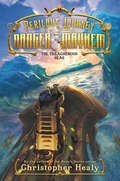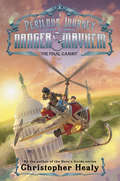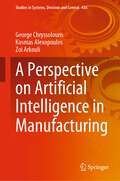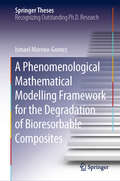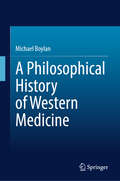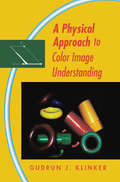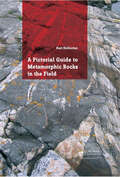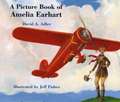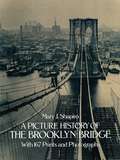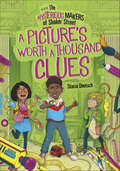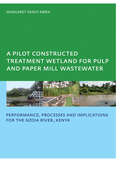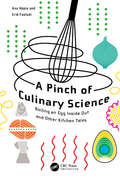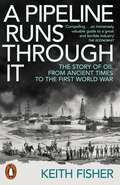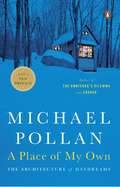- Table View
- List View
A Paraconsistent Decision-Making Method (Smart Innovation, Systems and Technologies #87)
by Jair Minoro Abe Fábio Romeu CarvalhoThis book presents a novel decision-making support system based on paraconsistent annotated evidential logic, which directly handles imprecise, incomplete and contradictory data. The authors offer insights into areas such as engineering and biomedicine, as well as related fields. Decision analysis is useful in making choices when the consequences of actions are uncertain, like in business administration, where it assists in making investment decisions, and in health care, Decision analysis is also valuable when the possible actions may lead to conflicting consequences. A fundamental tenet of decision analysis is that even though the available information is incomplete, a decision must be made. Thus, analyses often contain assumptions about or estimates of missing data.The contribution that this method can provide to professionals and companies has significant relevance in terms of the impact of information systems on productivity and quality of the companies; the lack of training companies for proper planning and management of information systems; and the need for interdisciplinary treatment of several sectors of almost all related scientific areas.This book is a valuable resource for professionals seeking a competitive edge in their performance.
A Parametric Framework for Modelling of Bioelectrical Signals (Series in BioEngineering)
by Yar M. MughalThis book examines non-invasive, electrical-based methods for disease diagnosis and assessment of heart function. In particular, a formalized signal model is proposed since this offers several advantages over methods that rely on measured data alone. By using a formalized representation, the parameters of the signal model can be easily manipulated and/or modified, thus providing mechanisms that allow researchers to reproduce and control such signals. In addition, having such a formalized signal model makes it possible to develop computer tools that can be used for manipulating and understanding how signal changes result from various heart conditions, as well as for generating input signals for experimenting with and evaluating the performance of e. g. signal extraction methods. The work focuses on bioelectrical information, particularly electrical bio-impedance (EBI). Once the EBI has been measured, the corresponding signals have to be modelled for analysis. This requires a structured approach in order to move from real measured data to the model of the corresponding signals. This book proposes a generic framework for this procedure. It can be used as a guide for modelling impedance cardiography (ICG) and impedance respirography (IRG) signals, as well as for developing the corresponding bio-impedance signal simulator (BISS).
A Parent's Guide to Virtual Learning: How to Help Your Child Thrive in a Online Classroom
by Felicia DurdenMake kids&’ virtual school experience fun and effective with this all-in-one primer designed to help busy parents make the most out of digital platforms, understand teaching strategies, and fully support your child&’s education.Every parent wants to help their child succeed, but it can be difficult when online platforms and teaching methods seem to be constantly changing. Now, A Parent&’s Guide to Virtual Learning takes the mystery out of digital education and gives you the tools that you can immediately implement at home, no matter your district, school, or distance learning model. Written by a fellow parent and experienced educator, Dr. Felicia Durden breaks down how virtual learning works and simple strategies for reinforcing classroom instruction, all with the busy parent in mind. In this book, parents will learn how to: Create an inspiring at-home workspace Make the most out of virtual platforms Understand core topics like math and reading Set up remote learning pods with other kids Support various online, hybrid, and distance learning models Avoid burnout (for students and parents!) Adapting to a virtual environment will be challenging and the role that parents play is crucial in student success. This book will be a tool that you will go to again and again to stay prepared and energized each day to help your child reach their learning goals.
A Partially Auxetic Metamaterial Inspired by the Maltese Cross (Elements in Emerging Theories and Technologies in Metamaterials)
by Teik-Cheng LimA partially-auxetic metamaterial is introduced, inspired by the Maltese cross. Each unit of this metamaterial consists of a pair of counter-rotating equal-armed crosses, which is interconnected to neighboring units via hinge rods and connecting rods. Based on linkage theory, the on-axes Poisson's ratio was established considering a two-fold symmetrical mechanism, while the (anti)tetrachiral mechanisms were identified for on-axes uniaxial compression. A shearing mechanism is suggested for pure shearing and diagonal loading of the metamaterial with square array. Results suggest that the approximated infinitesimal models are valid for the Poisson's ratio of the two-fold symmetrical and the (anti)tetrachiral mechanisms under on-axis tension and compression, respectively; however, the finite model is recommended for quantifying the Poisson's ratio under pure shear and off-axis loading. This metamaterial manifests microstructural trinity, in which three different loading modes result in three different groups of deformation mechanisms. Finally, suggestions are put forth for some unsolved predictive problems.
A Passion for Space: Adventures of a Pioneering Female NASA Flight Controller (Springer Praxis Books)
by Marianne J. DysonMarianne J. Dyson recounts for us a time when women were making the first inroads into space flight control, a previously male-dominated profession. The story begins with the inspiration of the Apollo 11 landing on the Moon and follows the challenges of pursuing a science career as a woman in the 70s and 80s, when it was far from an easy path. <p><p>Dyson relates the first five space shuttle flights from the personal perspective of mission planning and operations in Houston at the Johnson Space Center, based almost exclusively on original sources such as journals and NASA weekly activity reports. The book's historical details about astronaut and flight controller training exemplify both the humorous and serious aspects of space operations up through the Challenger disaster, including the almost unknown fire in Mission Control during STS-5 that nearly caused an emergency entry of the shuttle. <p><p>From an insider with a unique perspective and credentials to match, this a must-read for anyone interested in the workings of NASA during one of its busiest and defining times, and the challenges faced by women pursuing scientific careers.
A Path To The Next Generation Of U.s. Banknotes: Keeping Them Real
by National Research Council of the National AcademiesThe rapid pace at which digital printing is advancing is posing a very serious challenge to the U.S. Department of the Treasury’s Bureau of Printing (BEP). The BEP needs to stay ahead of the evolving counterfeiting threats to U.S. currency. To help meet that challenge, A Path to the Next Generation of U.S. Banknotes provides an assessment of technologies and methods to produce designs that enhance the security of U.S. Federal Reserve notes (FRNs). This book presents the results of a systematic investigation of the trends in digital imaging and printing and how they enable emerging counterfeiting threats. It also provides the identification and analysis of new features of FRNs that could provide effective countermeasures to these threats and an overview of a requirements-driven development process that could be adapted to develop an advanced-generation currency.
A Pathway to Safe, Smart, and Resilient Road and Mobility Networks: The Future of Roadways: Green, Equitable, and Integrated (Advances in Science, Technology & Innovation)
by Amin Akhnoukh Kamil Kaloush Mena I. Souliman Carlos ChangThis book provides case studies and state-of-the-art research findings for cutting-edge technologies relevant to transportation infrastructure projects, with emphasis on safe, smart, and resilient road and mobility networks. The market share of the global infrastructure projects is estimated at $3.4 trillion, the socioeconomic rate of return is around 20%, and significant progress has been made in the last decade in maintenance of existing projects and to improve future construction projects for the well-being of the society. Different book chapters focus on emerging challenges including readying road infrastructure to autonomous vehicles, safety of road users, increased efficiency and sustainability of infrastructure projects, and advances in construction materials and technologies of highways, tunnels, and bridges. State-of-the-art research includes the current and future applications of unmanned aerial vehicles (UAV), intelligent transportation systems (ITS), artificial intelligence (AI), Internet of things (IoT), big data, smart materials, and additive manufacturing (AM). This book is intended for transportation professionals, policy makers, researchers, practicing engineers, researchers, graduate students, and public and private sector transportation personnel
A Pathway to Sustainable Landscapes: Integrating Agriculture, Urban Systems, and Natural Resources (Sustainable Landscape Planning and Natural Resources Management)
by Ayse Ozcan Buckley Asonja Aleksandar Evgeny PanidiThis book presents a collection of revolutionary research and case studies exploring innovative approaches to sustainable landscape design, green infrastructure, agricultural systems, geospatial technologies, and the development of resilient and livable cities. As the world faces escalating environmental challenges stemming from climate change, resource depletion, and biodiversity loss, there is an urgent need to identify and implement sustainable solutions. This book contributes to this imperative by showcasing research that advances both theoretical and practical knowledge in key domains critical to environmental sustainability and community resilience. The contributions in this book highlight the crucial role that cities play in addressing the global sustainability crisis. As urban populations continue to grow, so too do the demands on infrastructure, resources, and energy systems. Reconciling these increasing urban pressures with the need to protect and restore natural ecosystems is a central focus of the research presented. The chapters explore novel applications of renewable energy, green infrastructure, regenerative agriculture, and geospatial technologies as means of cultivating more ecologically sound and livable cities. Furthermore, the interdisciplinary nature of the research, spanning disciplines such as urban planning, environmental science, and agricultural technology, underscores the multifaceted nature of the sustainability transition. Collectively, the insights and case studies offered in this book provide invaluable guidance for researchers, policymakers, and practitioners dedicated to realizing a more equitable and environmentally resilient future.
A Perfect Harmony: Music, Mathematics and Science
by David DarlingFrom the earliest of civilisations, humans have found ways to make music, whether through makeshift drums or artfully drilled bone flutes. But how did music – effectively little more than a series of certain tones and rhythms – become so integral to the human experience? Untangling the curious links between notes and number, musical perception, psychology and physics, David Darling examines the fascinating science behind music, from its Palaeolithic origins to the present. Revealing surprising connections and busting pervasive myths, A Perfect Harmony asks: Why do musicians tend to be better at maths than non-musicians? Why do we find some pieces sad and others happy? Will playing Mozart to babies predispose them to genius? Could an AI write the perfect symphony?
A Perilous Journey of Danger and Mayhem #1: A Dastardly Plot (Perilous Journey of Danger and Mayhem #1)
by Christopher HealyA rip-roaring, hilarious alternate-history adventure starring the world’s most famous inventors—and its most forgotten. From the author of the beloved Hero’s Guide series, Christopher Healy.It's 1883—the Age of Invention! A time when great men like Thomas Edison, Alexander Graham Bell, Nicola Tesla, and George Eastman work to turn the country into a land of limitless opportunity.And it all happens at the world famous Inventor’s Guild headquarters in New York City—a place where a great idea, a lot of hard work, and a little bit of luck can find you rubbing elbows with these gods of industry who will usher humanity into the future.Unless, of course, you’re a woman.Molly Pepper, daughter of brilliant but unknown inventor Cassandra Pepper, lives with her mother in New York. By day, they make ends meet running a pickle shop; but by night, they toil and dream of Cassandra taking her place among the most famous inventors in America.In an attempt to find a way to exhibit Cass’s work at the World’s Fair, they break into the Inventor's Guild, where they discover a mysterious plot to destroy New York.The evidence points to the involvement of one of the world’s most famous inventors, and now it’s up to Molly, Cassandra, and a shop hand named Emmett Lee to uncover the truth—even if no one will ever know it was they who did it.“Christopher Healy, author of the Hero’s Guide series, knows how to tell a good story. He’s done it again with the adventures of a determined girl named Molly Pepper.”—Brightly, Best Middle Grade Books of Fall 2018
A Perilous Journey of Danger and Mayhem #2: The Treacherous Seas (Perilous Journey of Danger and Mayhem #2)
by Christopher HealyThe second book in the new adventure trilogy from the beloved author of The Hero's Guide to Saving Your Kingdom.It's 1883—only a few months after Molly Pepper; her mother, Cassandra; and her friend, Emmett, saved New York from an attack by the megalomaniacal Ambrose Rector while managing to preserve the reputations of Alexander Graham Bell and Thomas Edison, whose technology was manipulated in Rector’s scheme. Their selfless heroism will finally earn them a place in the Inventors’ Guild, alongside the greatest minds of their generation.Unless, of course, no one knows that they did any of that.Left with nothing but empty promises and a struggling pickle shop after the government chooses to cover up the crisis, Molly, Cassandra, and Emmett have no idea where to turn—until they learn of a daring expedition to the South Pole, where an meteorite of mysterious power is embedded, and where Emmett’s father, explorer and ship captain Wendell Lee, disappeared years ago. With the fate of the world hanging in the balance, our heroes commandeer an experimental seacraft to make their play on the pole. But the trip is more treacherous than they realize, and there’s no guarantee that they will return successful—if they even return at all.
A Perilous Journey of Danger and Mayhem #3: The Final Gambit (Perilous Journey of Danger and Mayhem #3)
by Christopher HealyThe thrilling conclusion to Christopher Healy's funny, action-packed, acclaimed alt-history adventure!It is 1884, and Molly and Cassandra Pepper, Emmett Lee, and Emmett’s long-lost father are sailing back to New York following their death-defying adventure in Antarctica. Having discovered a subterranean world at the South Pole while saving the world from certain doom once again, surely their accomplishments will finally earn them the recognition they deserve.Unless, of course . . . well, you know by now.And so do the Peppers and Lees. They’re used to having their deeds covered up by the government in order to protect powerful men, and frankly, they’re sick of it. And when their return to New York doesn’t go the way they’d planned, they decide that maybe it’s best to go into hiding and accept that, perhaps, the forces aligned against them are just too great.As the 1884 presidential election approaches, however, our heroes discover a plot against leading candidate Thomas Edison that only they can stop. It’ll be up to them to decide whether to come out of hiding, make the perilous journey to Washington, DC, and do the right thing one last time. Even if it means risking everything they have left.
A Perspective on Artificial Intelligence in Manufacturing (Studies in Systems, Decision and Control #436)
by George Chryssolouris Kosmas Alexopoulos Zoi ArkouliThis book investigates the rapid developments of Artificial intelligence (AI) as well as their capability to address efficiently and in a cost-effective manner issues of the manufacturing field. A number of manufacturing applications of AI related to manufacturing processes, robots, automation and manufacturing systems design and control, are presented and discussed. The book includes an outlook on a way forward to intelligent manufacturing, through AI. The real benefit from AI in manufacturing will not only derive through the automation of tasks but also through the provision of new levels of autonomy that will make entirely new applications possible and introduce new business processes in manufacturing.
A Phenomenological Mathematical Modelling Framework for the Degradation of Bioresorbable Composites (Springer Theses)
by Ismael Moreno-GomezThis book presents a generalised computational model for the degradation of resorbable composites, using analytic expressions to represent the interwoven phenomena present during degradation. It then combines this modelling framework with a comprehensive database of quantitative degradation data mined from existing literature and from novel experiments, to provide new insights into the interrelated factors controlling degradation. Resorbable composites made of biodegradable polyesters and calcium-based ceramics have significant therapeutic potential as tissue engineering scaffolds, as temporary implants and as drug-loaded matrices for controlled release. However, their degradation is complex and the rate of resorption depends on multiple connected factors such as the shape and size of the device, polymer chemistry and molecular weight, particle phase, size, volume fraction, distribution and pH-dependent dissolution properties. Understanding and ultimately predicting the degradation of resorbable composites is of central importance if we are to fully unlock the promise of these materials.
A Philosophical History of Western Medicine
by Michael BoylanThis book provides an historical and philosophical overview of Western medicine along with commentary about how past principles affect current problems in biomedicine like genetic engineering, transhumanism, and a commitment to environmentalism. The book spans Ancient, Hippocratic and Galenic texts, Medieval writings, Modern contributions, and contemporary discoveries in the history and philosophy of medicine, including the growing role of technology in the practice of medicine. This book is of essential reading material for scholars and students interested in the history and philosophy of science as it relates to medicine, as well as those interested in the normative consequences of the study of nature for our contemporary world, particularly as it relates to medicine, environmental ethics, and genetic engineering.
A Physical Approach to Color Image Understanding
by Gudrun J. KlinkerThe author presents a vision model that uses color information to interpret the effects of shading and highlights on a scene. Transcending more traditional approaches, this method may lead to more reliable and useful techniques for image understanding.
A Pictorial Guide to Metamorphic Rocks in the Field
by Kurt HollocherThis book is an illustrative introduction to metamorphic rocks as seen in the field, designed for advanced high school to graduate-level earth science and geology students to jump-start their observational skills. In addition to photographs of rocks in the field, there are numerous line diagrams and examples of metamorphic features shown in thin section. The thin section photos are all at a scale and in a context that can be related to views seen in the field through a hand lens. This book will serve as a pictorial atlas of metamorphic rocks, processes, and features. Suitable for a broad range of education, background, and interests.
A Picture Book of Amelia Earhart
by David A. AdlerDiscusses the life of the pilot who was the first woman to cross the Atlantic by herself in a plane.
A Picture History of the Brooklyn Bridge
by Mary J. ShapiroProfusely illustrated account of the greatest engineering achievement of the 19th century. Rare contemporary photos and engravings, accompanied by extensive, detailed captions, recall construction, human drama, politics, much more. 167 black-and-white illustrations.
A Picture's Worth a Thousand Clues (The Mysterious Makers of Shaker Street)
by Stacia DeutschTen-year-old Michael Wilson notices that strange things are happening at old Mrs. Vernon's house, just two doors down from his Shaker Street home. Crates are going in and out of the house all night long, and Mrs. Vernon, a curator at an art museum, has wet paint in her yard, of all places. Can Michael and his friends Liv and Leo put their maker skills to work and create some gadgets to figure out what the odd, old woman is up to? After the mystery's solved, readers can recreate the Mysterious Makers' tools with included instructions, and a glossary, discussion questions, and writing prompts offer reading support.
A Pilot Constructed Treatment Wetland for Pulp and Paper Mill Wastewater: Performance, Processes and Implications for the Nzoia River, Kenya, UNESCO-IHE PhD
by Margaret Akinyi AbiraThis study, conducted in Kenya, gives the first insight into the performance of a constructed treatment wetland receiving pulp and paper mill wastewater in the tropics.The wetland effectively removed organic matter, suspended solids, phenols and nutrients. BOD and phenols reduction rates are reported for the first time. Design parameters and guidel
A Pinch of Culinary Science: Boiling an Egg Inside Out and Other Kitchen Tales
by Anu Inkeri Hopia Erik Cyrus FooladiThis book provides a playground for the readers to practice and develop scientific thinking, by exploring the world of food in a fun way. The authors take the role of someone trying to find interesting questions to ask about familiar, though often hidden, phenomena. Claims (or myths) on everyday cooking provide numerous cases for this. Using popular cooking myths as a springboard, this book discusses these riddles, interweaving a scientific rationale for the phenomena with a culinary or craftsman explanation. This book covers not only science (physics, chemistry, biology) but also cultural aspects (tradition, history, emotion), of what food/cooking is all about.
A Pipeline Runs Through It: The Story of Oil from Ancient Times to the First World War
by Keith Fisher'Fascinating revelations' Max Hastings, Sunday Times'An immensely valuable guide to a great and terrible industry' The Economist 'The book I have long been waiting for... Essential reading' Michael KlarePetroleum has always been used by humans: as an adhesive by Neanderthals, as a waterproofing agent in Noah's Ark and as a weapon during the Crusades. Its eventual extraction from the earth in vast quantities transformed light, heat and power. A Pipeline Runs Through It is a fresh, in-depth look at the social, economic, and geopolitical forces involved in our transition to the modern oil age. It tells an extraordinary origin story, from the pre-industrial history of petroleum through to large-scale production in the mid-nineteenth century and the development of a dominant, fully-fledged oil industry by the early twentieth century.This was always a story of imperialist violence, economic exploitation and environmental destruction. The near total eradication of the Native Americans of New York, Pennsylvania and Ohio has barely been mentioned as a precondition for the emergence of the first oil region in the United States. The growth of Royal Dutch-Shell involved the genocidal subjugation of people of the Dutch East Indies and the exploitation of oil in the Middle East arose seamlessly out of Britain's prior political and military interventions in the region. Finally, in an entirely new analysis, the book shows how the British navy's increasingly desperate dependence on vulnerable foreign sources of oil may have been a catalytic ingredient in the outbreak of the First World War.The rise of oil has shaped the modern world, and this is the book to understand it.
A Place of My Own: The Architecture of Daydreams
by Michael PollanMichael Pollan's unmatched ability to draw lines of connection between our everyday experiences- whether eating, gardening, or building-and the natural world has been the basis for the popular success of his many works of nonfiction, including the genre-defining bestsellers The Omnivore's Dilemma and In Defense of Food. With this updated edition of his earlier book A Place of My Own, readers can revisit the inspired, intelligent, and often hilarious story of Pollan's realization of a room of his own-a small, wooden hut, his "shelter for daydreams"-built with his admittedly unhandy hands. Inspired by both Thoreau and Mr. Blandings, A Place of My Own not only works to convey the history and meaning of all human building, it also marks the connections between our bodies, our minds, and the natural world.
A Plague of Sheep
by Elinor G. K. MelvilleThis is a book about the biological conquest of the New World. Taking as a case study the sixteenth-century history of a region of highland central Mexico, it shows how the environmental and social changes brought about by the introduction of Old World species aided European expansion. The book spells out in detail the environmental changes associated with the introduction of Old World grazing animals into New World ecosystems, demonstrates how these changes enabled the Spanish takeover of land, and explains how environmental changes shaped the colonial societies.
